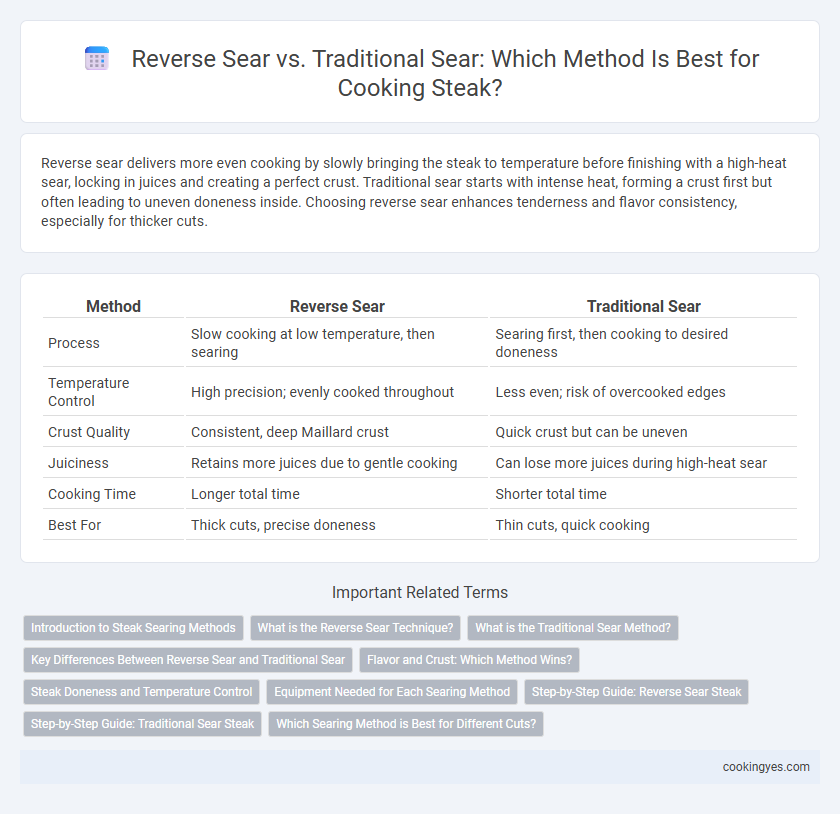Reverse sear delivers more even cooking by slowly bringing the steak to temperature before finishing with a high-heat sear, locking in juices and creating a perfect crust. Traditional sear starts with intense heat, forming a crust first but often leading to uneven doneness inside. Choosing reverse sear enhances tenderness and flavor consistency, especially for thicker cuts.
Table of Comparison
| Method | Reverse Sear | Traditional Sear |
|---|---|---|
| Process | Slow cooking at low temperature, then searing | Searing first, then cooking to desired doneness |
| Temperature Control | High precision; evenly cooked throughout | Less even; risk of overcooked edges |
| Crust Quality | Consistent, deep Maillard crust | Quick crust but can be uneven |
| Juiciness | Retains more juices due to gentle cooking | Can lose more juices during high-heat sear |
| Cooking Time | Longer total time | Shorter total time |
| Best For | Thick cuts, precise doneness | Thin cuts, quick cooking |
Introduction to Steak Searing Methods
Steak searing methods primarily include the reverse sear and traditional sear techniques, each affecting flavor and texture differently. Traditional sear involves cooking the steak at high heat first to create a caramelized crust, followed by finishing at a lower temperature, while reverse sear starts with low-temperature cooking before searing. Understanding these methods helps optimize the Maillard reaction for a tender, flavorful steak.
What is the Reverse Sear Technique?
The reverse sear technique involves slow-cooking the steak at a low temperature before finishing with a high-heat sear to create a flavorful crust. This method ensures even cooking and a consistent medium-rare center, preventing overcooking common in traditional searing. Chefs prefer reverse searing for thick cuts like ribeye and filet mignon due to its precise temperature control and enhanced tenderness.
What is the Traditional Sear Method?
The Traditional Sear Method involves cooking the steak over high direct heat to quickly form a flavorful crust while locking in juices. This technique typically uses a hot skillet or grill, searing each side for a few minutes before finishing at a lower temperature if needed. It prioritizes intense, immediate heat to produce a caramelized exterior and a tender, juicy interior.
Key Differences Between Reverse Sear and Traditional Sear
Reverse sear involves slowly cooking steak at a low temperature before finishing with a high-heat sear, ensuring even doneness and a consistent crust. Traditional sear starts with high heat to create a crust, followed by finishing the interior at a lower temperature, often risking uneven cooking. Reverse sear offers better temperature control and juiciness, while traditional sear emphasizes a quicker, crispier exterior.
Flavor and Crust: Which Method Wins?
Reverse searing enhances steak flavor by cooking the meat evenly at a low temperature before creating a deeply caramelized crust, resulting in a tender, juicy interior with a rich, smoky exterior. Traditional searing delivers a quick, intense Maillard reaction that forms a crispy crust but risks overcooking the steak's interior. For maximum flavor and an irresistible crust, reverse searing consistently outperforms traditional searing by balancing texture and depth of taste.
Steak Doneness and Temperature Control
Reverse sear offers precise temperature control by slowly bringing the steak to the desired internal doneness before applying a high-heat sear, ensuring even cooking and a consistent medium-rare throughout. Traditional sear exposes the steak to intense heat initially, often resulting in a less controlled internal temperature and potential overcooking near the edges while the center remains underdone. For optimal steak doneness, reverse searing minimizes temperature gradients, producing a tender, evenly cooked steak with a perfect crust.
Equipment Needed for Each Searing Method
Reverse sear requires an oven or smoker to slowly cook the steak before finishing with a hot skillet or grill for a crust, while traditional sear relies primarily on a heavy-duty cast iron skillet or grill to cook the steak at high heat from the start. Reverse searing demands precise temperature control tools such as a digital meat thermometer to monitor internal doneness during the low-temperature phase. Traditional searing needs minimal equipment beyond a quality pan and heat source but offers less control over internal steak temperature compared to reverse sear methods.
Step-by-Step Guide: Reverse Sear Steak
Begin by seasoning the steak generously and slowly cooking it in a low-temperature oven at 225degF (107degC) until it reaches an internal temperature of about 110degF (43degC). Next, heat a cast-iron skillet over high heat until smoking, then sear the steak for 1-2 minutes per side to form a deeply caramelized crust. Finish by resting the steak for 5 minutes to allow juices to redistribute, ensuring a tender and evenly cooked interior with a perfect crust.
Step-by-Step Guide: Traditional Sear Steak
Start by bringing the steak to room temperature to ensure even cooking, then season generously with salt and pepper. Heat a cast-iron skillet over high heat until smoking hot, and add a small amount of oil with a high smoke point like canola or grapeseed oil. Sear the steak for 2-3 minutes per side to develop a deep brown crust, then reduce heat and continue cooking until the desired internal temperature is reached, resting for 5 minutes before slicing.
Which Searing Method is Best for Different Cuts?
Reverse sear excels with thick cuts like ribeye and filet mignon, providing even cooking and a perfect crust by slowly bringing the steak to temperature before searing. Traditional sear suits thinner cuts such as sirloin or flank steak, offering quick caramelization without overcooking the interior. Choosing the ideal searing method depends on steak thickness and desired doneness, ensuring optimal flavor and texture.
Reverse Sear vs Traditional Sear for Steak Infographic

 cookingyes.com
cookingyes.com